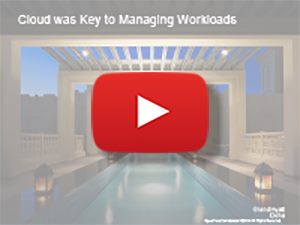Mike Cohen remembers the early days of the Hyatt Hotels "internal portal" about 10 years ago.
Sometimes he tries to forget them.
The hotel chain's director of communications systems recalled a small internal portal that grew into a company-wide collection of HTML pages.
And you needed to work with an IT administrator to produce content.
"It lacked the ability to search for information and didn't give people the ability to share content or collaborate with other individuals," Cohen said during a CMSWire webinar last week.
So, Hyatt went to work.
The result? A better intranet at the Chicago-based hotel chain — and a 500 percent increase in intranet use among its 75,000-employees over the last five years.
The improved intranet today is powered by Waterloo, Ontario-based provider OpenText's cloud infrastructure. Hyatt partnered with OpenText a couple years ago because of its upgrade help, licensing model, content management experience and 24/7 support Hyatt needed as intranet use increased.
Why the Cloud?
When Hyatt decided to move the intranet to the cloud, OpenText came in "significantly cheaper" than its competitors, Cohen said during the CMSWire webinar, "Enterprise Cloud Solutions: Move Faster and Beat the Competition."
In addition, OpenText offered 24/7 support. "We couldn't do it ourselves," Cohen said.
He explained that OpenText supports any application. "Any problem you have you might see it as a database layer. But eventually you're going to have to go back to the application of the software and make configuration changes there. We don't have to have that expertise from a Hyatt standpoint and we can go to OpenText, which is very beneficial," he noted.
OpenText's upgrade capabilities are a "huge benefit," said Cohen, who added that the Hyatt team does have its share of customizations.
"It's our responsibility," he said, "but even setting up new hardware, putting on the latest version and applying patches are things OpenText helps with significantly."
OpenText's licensing program worked better than other vendors for Hyatt because about 60 to 70 percent of Hyatt employees do not use computers on the job.
"We'd rather pay for what we use," Cohen said. "If for some reason we get massive adoption and we need to scale, we can pay for it then instead of paying for upfront."
What Do End Users Get?
Stability, to start, Cohen said. "They see that 24/7 support they didn't see beforehand," he said.
Users get the capabilities of what he called a "world-class" intranet called Hyatt Connect, which makes it simple to find information.
"If you need to find the executive chef at a particular hotel, you can search that against the company directory," Cohen said. "We wanted our colleagues to feel like a part of the greater company. It allows hotels to communicate with other properties. Having a tool that's both a communications platform and an operations platform has benefited our employees."
Clouds Rising
Forrester Research analyst Sophia Vargas, who also spoke on the CMSWire webinar, said there has been hyper growth in the cloud market. Officials at the Cambridge, Mass.-based research firm predict global cloud purchases will rise from $72 billion in 2014 to $191 billion in 2020.
Forrester researchers expect Software-as-a-Service will remain the largest of public cloud revenue at two-thirds.
Enterprises initially moved to the cloud because of the ease of use and cost efficiencies. It was cheaper than maintaining an on-premise structure, Vargas said.
Now enterprises look to the cloud for business agility, new updates and new services and the ability to quickly meet market demands without the initial cost and expense, she said.
"They're using cloud now as a strategic enabler for broader initiatives," she added.
Cloud Strategy
Vargas suggested those diving into a cloud hosting venture for their business take an holistic approach.
Characterize each individual application in your organization by profile. Is it a commodity? A service? Is it a differentiator?
Is it tied to the organization's profitability? Is it heavily customized? What is its dependency on the back-end infrastructure?
What expertise does it require to run? Who's using it and where? Are there specific compliance needs and business requirements?
Identify strong candidates for cloud infrastructure and ones that will never leave your internal system.

"Pay attention and take advantage of the cloud economics," Vargas said.
"Cloud can be cheaper if used correctly but it can also help to deliver additional value. Identify the correct workload that will take advantage of scale-up capabilities but then also scaling down with performance monitoring and application optimization and design."
And remember, any move to the cloud means a significant culture shift.
"There will be changing roles, changing responsibilities,and with skills going out of house and in-house," Vargas said.
"Encourage best practices as you continue to accelerate cloud usage in the correct manner. At the end of the day you're moving from builder to operator to broker of cloud services. Most likely you'll be using a bevy of different types of solutions of clouds. You're going to be helping to point users in right direction while providing the right level of access and governance across each solution."
 Title image by JD Hancock
Title image by JD Hancock
